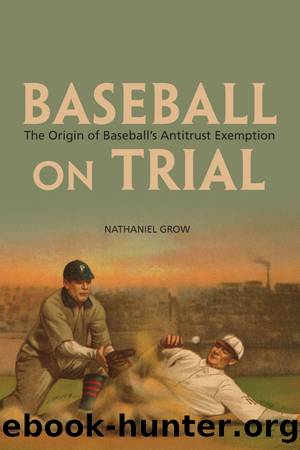Baseball on Trial by Nathaniel Grow

Author:Nathaniel Grow
Language: eng
Format: epub
Publisher: University of Illinois Press
Published: 2014-10-15T00:00:00+00:00
Justice Wendell P. Stafford presided over Baltimoreâs trial in Washington, D.C. (Library of Congress, Prints & Photographs Division, LC-H25-105830-G, photograph by Harris & Ewing)
The trial opened on March 25 with a number of baseball luminaries in attendance, including all three members of the National Commission as well as representatives of at least five different major league teams. Following the selection of the (all-male) jury, William Marbury presented a two-hour-long opening statement on behalf of Baltimore. Marbury began by warning the jurors that they were likely in for a lengthy trial, but one that he hoped would be ânot altogether uninteresting.â He then assured the jury that the plaintiff had no desire to steal Washingtonâs franchise or to hurt the national pastime in any way. Quite to the contrary, he praised baseball as developing the finest qualities in the nationâs youth, crediting the sport with having âmade the American soldier almost invincible upon the [World War I] battlefields of Europe last year.â41
The Baltimore attorney then explained the legal basis for the lawsuit, describing the Sherman Act to the jury. In particular, he emphasized the antimonopoly provisions contained in Section 2 of the act, promising the jurors that he would prove that organized baseball was âthe most complete, the most perfect, and the most ruthless monopoly that the American people ever had an opportunity to see.â From there, Marbury launched into an extended discussion of the history of organized baseball dating back to 1894. During his exposition, the attorney talked about the formation of the National Agreement in 1903, and the ways in which it constrained professional players through both the reserve clause and blacklist. He asserted that this control over the players enabled organized baseball to monopolize the industry.42
Marbury went on to describe the formation of the Federal League, praising its foundersâ intentions of bringing major league ball to some of the large cities neglected by organized baseball. He noted that the Baltimore shareholders had invested upward of $240,000 in their franchise, and documented how the team had been forced to pay exorbitant salaries to players to persuade them to disregard the reserve clause and risk being blacklisted by the major leagues. He also discussed the peace agreement of December 1915, emphasizing that Baltimore had never been notified of the pending settlement until a tentative deal had already been reached. Although he acknowledged that Baltimoreâs attorney Stuart Janney was present at the settlement conference and had inquired about obtaining a major league team for his city during the peace proceedings, Marbury stressed that the lawyer had never been authorized by the plaintiff corporation to negotiate on the teamâs behalf. Nevertheless, he justified Janneyâs actions by comparing him to âa man whose ship is being sunk by a pirate, and who tries to get on the pirateâs ship rather than drown,â arguing that âit does not lie in the mouth of the pirate to reproach him for doing it.â43
Finally, Marbury addressed some of organized baseballâs anticipated defenses in the case. He stressed
Download
This site does not store any files on its server. We only index and link to content provided by other sites. Please contact the content providers to delete copyright contents if any and email us, we'll remove relevant links or contents immediately.
The Social Psychology of Inequality by Unknown(2316)
The Plant Paradox by Dr. Steven R. Gundry M.D(2049)
The Writing on the Wall by Anselm Jappe(1762)
Working for Yourself by J.D. (Nolo) Stephen Fishman(1480)
Every Landlord's Legal Guide by Janet Portman & Stewart Marcia & Ralph Warner(1329)
The First 20 Hours: How to Learn Anything ... Fast by Kaufman Josh(1309)
ADHD on Trial by Michael Gordon(1243)
Decisive by Chip Heath(1202)
Drafting Contracts: How and Why Lawyers Do What They Do, Second Edition by Stark Tina L(1175)
Working for Yourself by Stephen Fishman J.D. (Nolo)(1141)
The Economist Aug 8th 2015 by The Economist(1125)
Restitution by Restitution(1116)
The Economist Aug 29th 2015 by The Economist(1100)
A Practical Guide to International Arbitration in London by Hilary Heilbron(1085)
Intellectual Property Strategy by John Palfrey(1084)
The Lord of the Rings: The Fellowship of the Ring, the Two Towers, the Return of the King by J. R. R. Tolkien(1084)
Collusion by Luke Harding(1047)
Persuasion by Owner(1018)
Chapter 1 by Owner(955)
